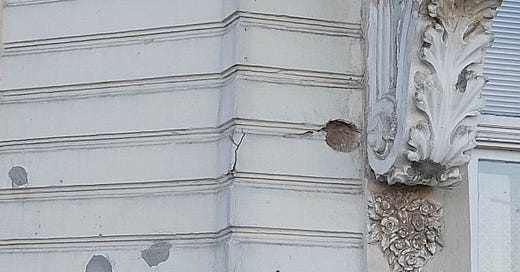For visitors to Osijek, the signs are so small, they may pass unnoticed. For residents, they are so ubiquitous as scarcely even to warrant notice.
But they are there all right. Unrepaired pockmarks in the sides of buildings; scars on the tarmac tracing where, a little over thirty years ago, countless shards of red-hot metal rent the ground, the air, and anyone in their path.
The city's past of 1991-92, when 1600 residents were killed; 80% of the remainder fled; and many buildings were reduced to rubble: all of this is Ukraine's present. It's exactly what's happening right now.
Only worse. Already, the death toll in Ukraine is between four and eight times what it was in the Croatian War. Many of the weapons being used are bigger; more devastating; even deadlier.
And it all makes me wonder: How will Ukraine fare once the fighting is over and — it is devoutly to be hoped — the savage occupiers have been expelled? What vast construction works — to say nothing of repairing the social fabric — will need to be undertaken? And over how long, and at what expense? (And at whose?)
Osijek has been transformed during the decades since the late 1990s: so much smart new construction and improved roads; old buildings often beautifully renovated or, at least, decently patched up. It's a nice place.
And yet. The population has declined sharply from what it was before 1991. Then, it was 140,000; now, it is, at best, 100,000, and sliding.
Is this the fate that awaits the towns and cities of eastern and southern Ukraine? Of course, their populations have plummeted now to a small fraction of what they were at this time last year — and many will come back once the fighting is over. But there are also many reasons for people to stay away for good. Destroyed homes that will either never be rebuilt, or will be replaced only after several years — with all the personal effects, treasures, photos, diploma certificates, lost and obliterated. What's to return to? And that is before we consider the memories people would prefer not to face on a daily basis. Better, many will feel, to start somewhere new. To continue the new lives they have already started in Vinnitsya, Wrocław, or Wolverhampton.
In eastern Croatia, many no longer wished to return to live alongside neighbours who had collaborated with the enemy — or even inflicted crimes on their behalf. And something similar will be true in parts of Ukraine.
The economy, too, will never be what it once was. If you respond "Ah! But eastern Ukraine is amazing farmland — the breadbasket of the nation!" ... well, the same thing was true here.
Perhaps even Mariupol will be rebuilt. (After all, Vukovar has been.) But that does not mean the former inhabitants will want to inhabit it. The first-time visitor to Vukovar always thinks they’ve arrived on a quiet day. Trust me: that’s a normal day. Even once the shiny new shopping malls are in place, with swiftly built apartments to house the consumers and smart new roads to shuttle them from one to the other, many will just drift away. There will still be the tell-tale shrapnel marks to indicate to those who know: this was once a war zone.







When u r in Swansea ( did we decide a date?) I will when on our way to a local hostelry …. Show you the shrapnel marks on many buildings and evidences of bombs having dropped !!